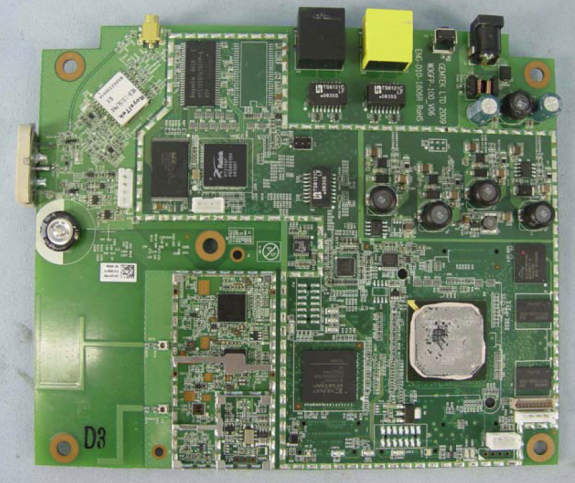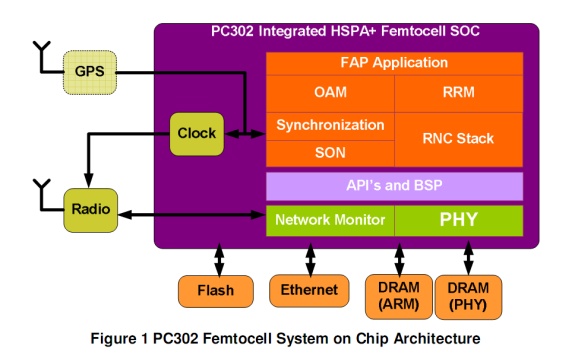AT&T 3G MicroCell: A Comprehensive Exploration
by Brian Klug on April 1, 2010 1:55 AM EST- Posted in
- Smartphones
- AT&T
- Microcell Review
- Mobile
Inside that white shell
So we now know there's relatively little to be learned about the device on the software side. What about the hardware itself? Again, our semiconductor-possessed sensibilities wouldn't be happy unless we got to see what's at this thing's core. I was eager to tear open the box and void some warranties like nobody's business, until I discovered something while doing my homework online that made me stop. Several users on the AT&T Forums reported that they were called by tech support because their MicroCell's tamper switch had been triggered. You read that right, the MicroCell has a built in physical tamper switch. They're that serious about you not getting into this thing. Rather than render the box useless before I even got to use it, I decided on another route.
Instead, I got the FCC ID off the bottom of the box (it's MXF-3GFP980217) and found the FCC filing online. Luckily, the internal photos of the device are freely available and of marginally passable quality. The most important photo is this one, of the board's topside with the heatsink removed:
That's some horrendous barrel distortion, FCC cameraman
I've tried locating the physical tamper switch and can't quite find it, though I'm certain it's there somewhere. Starting from the left, we can see the GPS chipset (RoyalTek) and the external connector just above it. There's also a trace to the Cirocomm internal GPS antenna which is the white square protruding from the board at far left. Running along the top of the board are the two ethernet connectors, reset pin, and DC power in. On the left we can also see two relatively thick traces for the antenna, likely Rx and Tx for the air interface. Interestingly, there are some connector headers also visible at the base of where those traces emerge from the amplifiers. Just south of the GPS RoyalTek chip is a flash TSOP, a Ralink RT2150F chip, and some DRAM up top. Searching for that particular Ralink chip revealed nothing. Given that Ralink traditionally makes wireless access point SoCs and wireless adapters, it's possible this is the device's radio. It's also possible that this is handling routing and ethernet for that "priority mode" configuration mentioned earlier.
Moving right, there's something we don't see every day - except in the domain of high speed signal processing - a Xilinx Spartan 3A FPGA sitting right alongside the platform's SoC. If you squint, you can make out picoChip under that thermal paste, along with 302. It's highly likely this board is using the picoChip PC302 SoC. Remember that 4 simultaneous phone limitation earlier? The PC302 is the only 3GPP Release 7 WCDMA (HSPA) SoC baseband picoChip makes with that implicit restriction, so it's very likely this is what we're seeing here. There's some RAM alongside at right, but it's impossibly hard to make out the markings.
The PC302 is the core of the MicroCell, incorporating a 400 MHz ARM11 processor as well as hardware accelerator support for IPsec, ethernet, and everything you need for a femtocell. Unsurprisingly, picoChip calls this a WCDMA Femto Access Point (FAP) supporting up to 4 users, and 21 Mbps HSDPA, 5.7 Mbps HSUPA. Keep in mind here that although the controller supports a physical layer data rate at those speeds, the air interface, protocol, and implementation limit the speeds further. We'll see that in practice, speeds are lower.












63 Comments
View All Comments
leexgx - Friday, April 2, 2010 - link
the UMA thing looks good idea, seems Way more piratical then these base stations ( http://en.wikipedia.org/wiki/Generic_Access_Networ... ) only ever seen it on blackberry phones thought, only issue i could see with them is if it doe snot work with the wireless router correctly or intermittently out of range of routerjulioromano - Friday, April 2, 2010 - link
Very nice and geeky review.Thanks for all the infos!
Simozene - Friday, April 2, 2010 - link
1. These units need to be very cheap or free for consumers.2. Any minutes or data usage that is routed over this instead of AT&Ts regular network should not be counted towards the limits on your data plan. It's not their network so you should not have to pay for using it.
If those two conditions are met I can see how this could be a very useful product.
sxr7171 - Friday, April 2, 2010 - link
But it's not. It can't even hand off properly.Chrisg331 - Friday, April 2, 2010 - link
1st off, great article. Good methodology as well. Will you be able to test different handsets (Primarily different chipsets/antenna designs to eliminate bias on the dropped calls), possibly test a repeater (as mentioned before) and possibly test data usage pattern(s) for those that may be bandwidth capped on their broadband? Great job. Could really be useful to those looking to ditch landlines.GregHH - Friday, April 2, 2010 - link
In your haste to slam AT&T you neglect to notice that the other cell carriers offer the same type of device. That implies their coverage must not be perfect and all encompassing. Everyone seems to think cell coverage should be ubiquitous whether in a metro area or in the wilderness. I feel good that my area finally got 3G coverage in December of 2010.JKflipflop98 - Saturday, April 3, 2010 - link
So, we're in the future looking back on the past then? Or we're in the past looking towards the current? Oh God, my head's going to explode.ivwshane - Friday, April 2, 2010 - link
There is no required monthly cost. Buy just the microcell and use your existing minutes and data plan. Buy a microcell with a $20 feature and you can have unlimited minutes while using it and you also get a $100 rebate.No one is forcing anyone to buy these, at&t is simply giving it's users a choice, if you want to improve your in home coverage then buy one, otherwise don't.
mikeshady - Saturday, April 3, 2010 - link
So if I understand it correctly the price,$20/month unlimited calling$10/month with AT&T DSL
$0 with AT&T landline.
Will i be able to use it for the unlimited free since i have att landline
mrSHEiK124 - Tuesday, April 6, 2010 - link
Those failed handover videos; that happens ALL OF THE TIME on at&t in the Tampa, FL area. If you're on a highway or main-road and venture off into the boonies, as you get booted off 3G all you can hear is distortion (the handover is successful and the call doesn't drop, but good luck continuing the phone call...) and weird audio artifacts. at&t...more bars in more places.